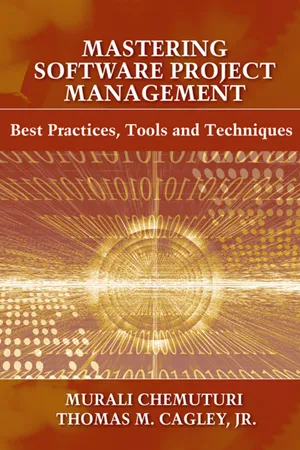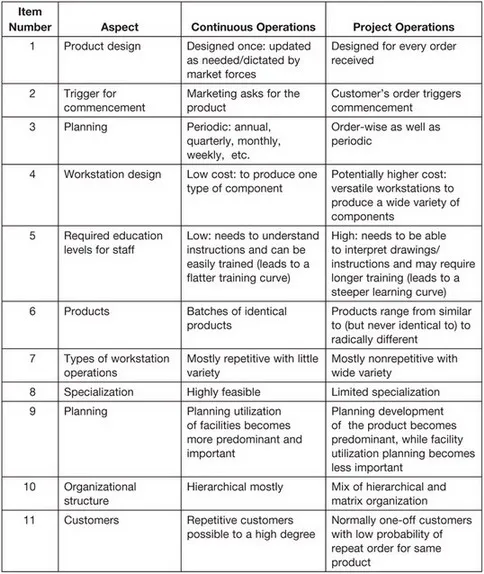
eBook - ePub
Mastering Software Project Management
Best Practices, Tools and Techniques
- 408 pages
- English
- ePUB (mobile friendly)
- Available on iOS & Android
eBook - ePub
Mastering Software Project Management
Best Practices, Tools and Techniques
About this book
This unique guide explains software project management from the standpoint of a software project manager working in a professional software development organization. It covers the subject of software project management in its entirety, including project acquisition and execution with backward linkages to concepts that play a facilitation role in successful project management, such as general management, decision making, people management, motivation, productivity and expectations management. This comprehensive reference provides all the guidance, best practices, tools and techniques needed to master software project management and achieve superior results.
Frequently asked questions
Yes, you can cancel anytime from the Subscription tab in your account settings on the Perlego website. Your subscription will stay active until the end of your current billing period. Learn how to cancel your subscription.
At the moment all of our mobile-responsive ePub books are available to download via the app. Most of our PDFs are also available to download and we're working on making the final remaining ones downloadable now. Learn more here.
Perlego offers two plans: Essential and Complete
- Essential is ideal for learners and professionals who enjoy exploring a wide range of subjects. Access the Essential Library with 800,000+ trusted titles and best-sellers across business, personal growth, and the humanities. Includes unlimited reading time and Standard Read Aloud voice.
- Complete: Perfect for advanced learners and researchers needing full, unrestricted access. Unlock 1.4M+ books across hundreds of subjects, including academic and specialized titles. The Complete Plan also includes advanced features like Premium Read Aloud and Research Assistant.
We are an online textbook subscription service, where you can get access to an entire online library for less than the price of a single book per month. With over 1 million books across 1000+ topics, we’ve got you covered! Learn more here.
Look out for the read-aloud symbol on your next book to see if you can listen to it. The read-aloud tool reads text aloud for you, highlighting the text as it is being read. You can pause it, speed it up and slow it down. Learn more here.
Yes! You can use the Perlego app on both iOS or Android devices to read anytime, anywhere — even offline. Perfect for commutes or when you’re on the go.
Please note we cannot support devices running on iOS 13 and Android 7 or earlier. Learn more about using the app.
Please note we cannot support devices running on iOS 13 and Android 7 or earlier. Learn more about using the app.
Yes, you can access Mastering Software Project Management by Murali Chemuturi,Thomas Cagley in PDF and/or ePUB format, as well as other popular books in Business & Project Management. We have over one million books available in our catalogue for you to explore.
Information
1
SOFTWARE PROJECT BASICS

INTRODUCTION
Human endeavor, from its earliest hunter/gatherer roots, was carried out in teams, each with a hierarchy of roles. As civilization progressed, the need for structure and rules increased. A large farm is a team organization based on a simple hierarchy of an owner, overseers, and employed laborers. The Industrial Revolution created factories which required more complex hierarchies, both within teams and between teams. Factories aggregated the production of goods for consumption into concentrated units capable of greater productivity. To achieve this great jump in productivity, rules were developed to effectively run the factories. These developments were the genesis of the art and science of managing production, which has been called production management.
Classification of organizations. The type of production can be used to classify organizations based on the manner in which goods are produced. The categories are:
•Mass production: continuously produces the same products
•Batch production: produces goods in batches; each batch is similar, but not identical
•Flow process production: production of chemicals, pharmaceuticals, and fertilizer products, generation of electricity, etc.
•Job order production: produces tailor-made goods (i.e., goods are produced only when an order is received)
Initially, management texts focused on mass production, batch production, and flow process production systems (also known as “made to warehouse” production systems). In made to warehouse production systems, goods are produced and stored in warehouses for distribution. The significant feature of mass production and flow process production is that the rate of consumption/demand equals or exceeds the rate of production for the product. In batch production, the rate of production exceeds the rate of consumption/demand for the product. The goal of production management is to balance both rates.
Production management texts, however, did not address organizations such as ship building, aircraft manufacturing, heavy equipment manufacturing, etc. These organizations are known as job order production or made to order organizations. In made to order organizations, items are produced only after an order is received.
By leaving out job order “shops,” management texts also excluded organizations that constructed buildings, highways, and other infrastructure facilities. These types of organizations are certainly not serial production organizations even though they create wealth and employ people. Their work was classified as projects. Some knowledge, however, was gathered and released under the title of project management. Job order production system organizations latched onto this concept and became project-based production systems.
Presently, management theory addresses organizations in two basic categories: production organizations and service organizations. The art and science of managing these organizations has metamorphosed from production management to operations management.
Similarly, we can categorize organizations by the nature of their operations:
•Continuous operations: organizations with fixed facilities that carry out similar operations day after day continuously and produce products for stockpiling in warehouses (real or virtual)
•Project operations: organizations with fixed but flexible facilities that carry out dissimilar operations from day to day and produce only against a customer order
More and more organizations are moving toward project operations due to market forces, which put emphasis on individual preferences while reducing costs. Gone are the days of the famous words of Henry Ford, Sr.: “You can have the car of any color as long as it is black.”
The project operations category has seen significant development over the past few years under the title “mass customization.” Mass customization blends aspects of continuous and project operations.
Having put the concept of project operations in an historical perspective, see Table 1.1 for a comparison of continuous operations with project operations. Mass customization walks the line between the two extremes identified in Table 1.1, typically with most of the benefits of each, but with a greater reliance on self-directed teams that make hierarchies and matrix organizations very nervous.
Table 1.1. Comparisons of Continuous Operations with Project Operations

Description of a project. Let’s now examine what comprises a project: a project is a temporary endeavor with the objective of manufacturing (producing or developing) a product or delivering a service, while adhering to the specifications of the customer (including functionality, quality, reliability, price, and schedule) and conforming to international/national/customer/internal standards for performance and reliability. Translation:
•A project is a temporary endeavor.
•A project has a definite beginning and a definite ending.
•No two projects will be identical, although they may be similar.
•Each project needs to be separately approved, planned, designed, engineered, constructed, tested, delivered, installed, and commissioned.
•A project may be stand-alone or a component in a larger program.
•A project is executed in phases, with an initiation phase and one or more intermediate phases and a closing phase.
•Many projects have a transition phase (e.g., handover to customer).
•A project may extend through a maintenance phase.
A software development project (often shortened to software project) has the objective of developing a software product or maintaining an existing software product. Software development projects have several general attributes, including:
•The project has a definite beginning and a definite end.
•The project deliverable is functional software and related artifacts.
•Activities that may be included in a project are user and software requirements, software design, software construction, software testing, acceptance testing, and software delivery, deployment, and handover.
•Activities not included in a project are the activities of project selection/acquisition and post-handover.
Some of the more unique attributes of software development projects include:
•The primary output is not physical — in the sense that the primary deliverable is functional software and no tangible components are delivered — almost everything is inside a computer.
•Process inspection does not facilitate progress assessment — functional software or at least the code is the real measure of progress. In a manufacturing organization, one can see semifinished goods. The proof of work being pe...
Table of contents
- COVER
- TITLE
- COPYRIGHT
- CONTENTS
- FOREWORD
- PREFACE
- ABOUT THE AUTHORS
- WEB ADDED VALUE
- CHAPTER 1 SOFTWARE PROJECT BASICS
- CHAPTER 2 APPROACHES TO SOFTWARE PROJECT MANAGEMENT
- CHAPTER 3 SOFTWARE PROJECT ACQUISITION
- CHAPTER 4 SOFTWARE PROJECT INITIATION
- CHAPTER 5 SOFTWARE PROJECT PLANNING
- CHAPTER 6 SOFTWARE PROJECT EXECUTION
- CHAPTER 7 SOFTWARE PROJECT EXECUTION CONTROL
- CHAPTER 8 CHANGE MANAGEMENT IN SOFTWARE DEVELOPMENT PROJECTS
- CHAPTER 9 SCHEDULING
- CHAPTER 10 SOFTWARE PROJECT CLOSURE
- CHAPTER 11 AGILE PROJECT MANAGEMENT
- CHAPTER 12 PITFALLS AND BEST PRACTICES IN SOFTWARE PROJECT MANAGEMENT
- APPENDIX A. MANAGEMENT OF SOFTWARE DEVELOPMENT PROJECTS
- APPENDIX B. DECISION-MAKING FOR SOFTWARE PROJECT MANAGERS
- APPENDIX C. PEOPLE MANAGEMENT
- APPENDIX D. PRODUCTIVITY CONCEPTS FOR SOFTWARE PROJECT MANAGERS
- APPENDIX E. ISSUE RESOLUTION IN SOFTWARE PROJECT MANAGEMENT
- APPENDIX F. MEASUREMENT AND METRICS IN SOFTWARE DEVELOPMENT ORGANIZATIONS
- APPENDIX G. MEASUREMENT AND MANAGEMENT OF CUSTOMER SATISFACTION
- APPENDIX H. AN INTRODUCTION TO PERT/CPM
- APPENDIX I. ABBREVIATIONS
- APPENDIX J. TEMPLATES FOR SOFTWARE PROJECT MANAGERS